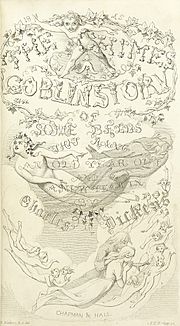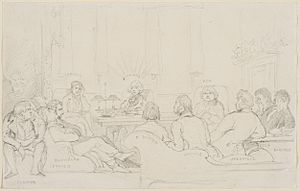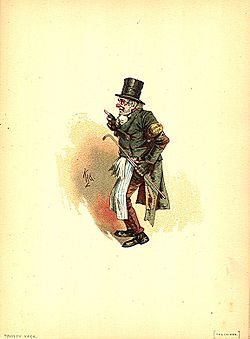The Chimes facts for kids

Title page of first edition, 1844 with engraving by F.P. Becker
|
|
| Author | Charles Dickens |
|---|---|
| Original title | The Chimes: A Goblin Story of Some Bells that Rang an Old Year Out and a New Year In |
| Illustrator | Daniel Maclise Richard Doyle John Leech William Clarkson Stanfield |
| Country | England |
| Language | English |
| Genre | Novella |
| Publisher | Chapman & Hall |
|
Publication date
|
1844 |
| Media type | Print (hardback & paperback) |
| Pages | 175 pp |
| Preceded by | A Christmas Carol |
| Followed by | The Cricket on the Hearth |
The Chimes: A Goblin Story of Some Bells that Rang an Old Year Out and a New Year In, often called The Chimes, is a short novel written by Charles Dickens. It was first published in 1844, one year after his famous story A Christmas Carol. This book is the second in a series of five "Christmas books" by Dickens. These stories, published in the 1840s, all share strong messages about society and doing what is right. Besides A Christmas Carol and The Chimes, the other Christmas books are The Cricket on the Hearth (1845), The Battle of Life (1846), and The Haunted Man and the Ghost's Bargain (1848).
Contents
How the Story Was Created
Dickens wrote The Chimes in late 1844 while he was visiting Italy. His friend and first biographer, John Forster, shared how Dickens got the idea. One day, Dickens was looking for a title and a plan for his next Christmas story. He was inspired by the loud sound of bells in Genoa, Italy, where he was staying.
All of Genoa was below him. Suddenly, the sound of all its church bells came to his ears. It was a loud, clashing, and jarring noise. It made his thoughts "spin around until they got lost in a whirl of frustration and dizziness, and then dropped dead."
Just two days later, Forster received a short letter from Dickens. It simply said: ""We have heard THE CHIMES at midnight, Master Shallow!"". This was the start of the book. Forster explained that Dickens wanted to write The Chimes to "strike a blow for the poor." This means he wanted to help the poor by writing about their struggles.
When he thought about his new Christmas story, he decided to make it a plea for the poor. He wanted to try and change society, just like he changed Scrooge. He wanted to show that society's happiness depends on kindness and charity, just as much as on justice.
Dickens returned to London for a week in December 1844. Before the book was published, he read it aloud to his friends. He wanted to see how they reacted to the story. The artist Daniel Maclise drew two pictures for The Chimes. He also attended two of these readings. Maclise created a famous drawing of Dickens reading the book on December 3, 1844.
What the Title Means
The "chimes" in the title are the old bells in the church. The main character, Trotty Veck, works near this church. The book is split into four parts, which Dickens calls "quarters." This is like the quarter-hour chimes of a striking clock. Dickens used similar ideas for his other Christmas books. For example, A Christmas Carol is divided into "staves" (like verses in a song). The Cricket on the Hearth is divided into "chirps."
Story Summary
It's New Year's Eve, and Trotty Veck, an old, poor "ticket-porter" (someone who runs errands), feels sad. He reads newspaper stories about crime and bad behavior. He wonders if working-class people are just naturally bad. His daughter, Meg, and her long-time boyfriend, Richard, arrive. They announce they will get married the next day. Trotty tries to hide his worries.
However, their happiness is ruined when they meet some important people. These include the proud Alderman Cute (a local official), a "political economist" (someone who studies how money and society work), and a young gentleman. These people make Trotty, Meg, and Richard feel like they don't even deserve to exist, let alone get married.
Trotty delivers a note for Alderman Cute to Sir Joseph Bowley, a rich Member of Parliament (MP). Sir Joseph gives money to the poor, but he acts like a bossy father figure. He proudly pays off his own debts for the new year. But he scolds Trotty because Trotty owes a small amount of rent and a few shillings to his local shop. Trotty cannot pay these debts.
Trotty goes home, convinced that he and other poor people are ungrateful. He believes they have no place in society. On his way, he meets Will Fern, a poor countryman, and his orphaned niece, Lilian. Will has been accused of vagrancy (being homeless and wandering). He wants to see Alderman Cute to fix things. But Trotty overheard a conversation at Sir Joseph Bowley's house. He warns Will that Cute plans to arrest and imprison him. Trotty takes Will and Lilian home. He and Meg share their small amount of food and poor lodging with them. Meg tries to hide her sadness. It seems her meeting with Cute and the others has made her decide not to marry Richard.
During the night, the church bells seem to call Trotty. He goes to the church and finds the tower door open. He climbs up to the bell chamber. There, he meets the spirits of the bells and their goblin helpers. They scold him for losing faith in people's ability to improve. They tell him he fell from the tower during his climb and is now dead. They say Meg's future life will be a lesson for him. Trotty then sees a series of visions. He watches, unable to help, as Meg, Richard, Will, and Lilian struggle through difficult lives over many years.
The bells want to teach Trotty an important lesson. They show him that people are not naturally bad. Instead, humans are meant to work towards better things. They only fail when they are crushed and pushed too far.
At the end of the book, Trotty wakes up at home. It's as if he was dreaming. The bells are ringing in the New Year on the very day he first climbed the tower. Meg and Richard have decided to get married after all. All their friends have come together to provide a wedding feast and celebration. The author lets the reader decide if this "awakening" was a dream within a dream. The reader must choose between the sad future shown in Trotty's vision or the happy wedding.
Main Characters
- Toby "Trotty" Veck: The main character, a poor old messenger.
- Margaret "Meg" Veck: Toby's 21-year-old daughter.
- Mrs. Anne Chickenstalker: The friendly local shopkeeper.
- Alderman Cute: A proud local official who acts as a judge.
- Mr. Filer: A "political economist" who believes in Utilitarianism (doing what is useful for the most people, sometimes without much kindness).
- Sir Joseph Bowley: A rich Member of Parliament (MP) who gives charity but acts like a strict boss.
- Will Fern: A poor man from the countryside.
- Lilian Fern: Will's niece, who is an orphan.
Important Messages
This story is like A Christmas Carol because it tries to convince readers of Dickens's moral ideas. The church bells represent time itself. The main messages of the story are shown through three wrongs the bells accuse Trotty of doing:
- Looking back to a perfect past that never really existed, instead of trying to make things better now.
- Believing that individual people's joys and sorrows don't matter to a higher power.
- Judging those who have fallen on hard times and offering them no help or kindness.
'Someone who turns away from people who have fallen and are struggling; who abandons them as worthless; and who does not look with pity at the dangerous path by which they fell from good—holding onto some bits of that lost ground, and still clinging to them when hurt and dying below; that person does wrong to Heaven and to humanity, to time and to forever. And you have done that wrong!'
Other Versions of the Story
- In 1914, the book was made into a silent film called The Chimes, directed by Thomas Bentley.
- A musical version of The Chimes was created in 1992 by Lisa Kofod and Gay Donat Reed, with music by Paul Johnson.
- The Chimes was made into a 24-minute clay-animated film in 2000 by Xyzoo Animation. It won an award in 2002.
- The Colonial Radio Theatre in Boston made a full radio play of The Chimes in 2000.
- In 2004, a stage play by Les Smith first appeared at the Southwark Playhouse.
- In 2015, Audible gave The Chimes as a free audiobook to its members for Christmas.
See also
 In Spanish: Las campanas (novela de Charles Dickens) para niños
In Spanish: Las campanas (novela de Charles Dickens) para niños



